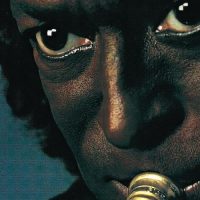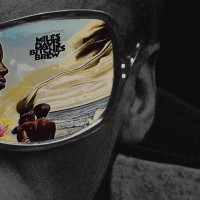Bassist Marcus Miller’s newest release, Renaissance, directly references his time as a member of the Miles Davis band in the 1980s — even as the 52-year-old continues to fuse jazz, R&B and rock after nearly three decades of work as a producer, sideman, composer and band leader.
Along the way, Miller has had Grammy-winning successes working with Luther Vandross (claiming 1992’s best R&B song nod for “Power of Love”), Chaka Khan, David Sanborn, Wayne Shorter and Bob James. His fourth solo instrumental effort, 2001’s M2, also earned a statue for best contemporary jazz album.
But, even today, Miller’s memorable period alongside Davis some 30 years ago remains a touchstone. Together, they produced six albums in the 1980s, including The Man with the Horn, We Want Miles, Star People, Tutu, Music From Siesta and Amandla. Miller was also part of the 2002 retrospective The Complete Miles Davis at Montreux.
[SOMETHING ELSE! REWIND: ‘Tutu’ was Miles Davis’ first record for a new label in some three decades, and the beginning of his final fully realized phase — with a powerful assist from Marcus Miller.]
Renaissance once again uses the 1986 Tutu project — on which Miller was writer or co-writer on all but two tracks — as inspiration.
“I was Miles’ bassist for a couple of years, but Tutu was the first time I wrote music for him,” Miller tells Eugene Holley Jr. of Ebony. “When you worked on something for Miles, the music didn’t have to be conventional. Whatever you think is good. And a lot of people are going to hear it, because it’s Miles. So yes, that period working for Miles really affected me.”
Unlike Miller’s recent Tutu Revisited, their ’86 collaboration is simply a leaping-off point this time. Renaissance quickly moves far afield, as Miller mixes and matches styles and guest voices at a furious rate. He’s joined by Ruben Blades and Dr. John on a set that includes interpretations of tracks by WAR, the Jackson Five and Janelle Monae, among others.
Sitting front and center throughout, of course, is Miller’s supple instrument.
“I came up in the glory years of the bass,” Miller adds. “So for me, the bass being in the front of the band was a very natural thing. The thing is: you’ve got to pick your spot. Because you still want to support your band. So on this album, it was really important for me to come in and out; to drive the band, from the bottom – the back of the bus – with the bassline, and then jump out in front and be melodic and sing with my bass. I really tried to found a good balance on this album.”
Here’s a look back at our recent thoughts on Marcus Miller and Miles Davis. Click through the titles for complete reviews …
MILES DAVIS – TUTU (1986): Most of the tracks sound much like funk-pop with dark chords and splashes of dissonance to give it the feel of Miles, without it being anything remotely like a classic Miles tune underneath the surface. This isn’t to say the songs were bad, though. The lead off title tune is a slow-tempo strut that evokes the cockiness that is part and parcel of the leader’s personality. “Portia” is another in a string one of Miller’s strong ballads. “Splatch” and “Full Nelson” are funk excursions that could as easily worked without Davis.
MARCUS MILLER – RENAISSANCE (2012): Miller, a two time Grammy winner who has been in the thick of funk, jazz, fusion and R&B for more than three decades, has seen a lot and his survey of the scene today gives him the urgency to hand down to younger generations the forward thinking approach to music he’s learned from the masters. “I feel like a page is turning,” he opines, “the last of our heroes are checking out and we are truly entering a new era. Musically, we’ve got all these cool ways to play and share music…but the music is not as revolutionary as the media. It’s time for a rebirth.” Renaissance isn’t a revolutionary album, but there’s an attention to detail, the openness to a multitude of styles, and Miller’s strongest set of songs in some time. All of those things seemed to inspire the younger generation of players in his band to play up to the material and respond to Miller’s direction with a rare combination of looseness and preciseness.
GIMME FIVE: OVERLOOKED MILES DAVIS RECORDINGS: A high profile artist whose work has been picked apart as much as Davis’ won’t have a lot of unturned stones despite some 45+ years of recording history. In fact, his entire Columbia catalogue from ‘Round Midnight’ in 1955 to ‘Bitches Brew’ in 1969 has been well regarded for many years now and are generally very easy to obtain; much of the same recordings even show up in different releases. So, we’ll ignore that big chunk to concentrate on albums outside the so-called golden era.
ONE TRACK MIND: DAVID SANBORN – “I TOLD U SO” (1983): A sublime slice of sultry, mid-tempo funk. The rich, shimmering chords coming from a cascading keyboard smooths the edge provided by the robotic drums humanized by Miller’s unmistakable funk slap bass. All that creates the perfect slab of groove for Sanborn to work his magic from. The first couple of rounds of chorus, Sanborn plays it straight, but afterwards, improvises with his alto sax nicely with arpeggios and other expressive devices that no matter what that was he never gets ahead or behind the beat. The late, lamented Hiram Bullock, who shares co-write credit for this song with Sanborn, supplies a short but sharp blues-based guitar solo.
[amazon_enhanced asin=”B007VIKOOG” /] [amazon_enhanced asin=”B0012OTVN0″ /] [amazon_enhanced asin=”B004DURSBC” /] [amazon_enhanced asin=”B00005JH7D” /] [amazon_enhanced asin=”B0007DBJ6E” /]
- Ernesto Cervini’s Turboprop, “When I Fall” (2024): Video premiere - March 15, 2024
- Disaster Pony,“Dead Neon & The Noon Sun” from ‘Disaster Pony’ (2024): Video premiere - February 27, 2024
- Christopher Hoffman, “Farewell Forever” from ‘Vision Is The Identity’ (2024): Streaming premiere - February 19, 2024



